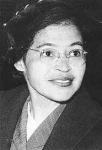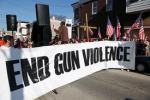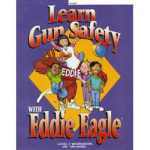Michael R. Weisser's Blog, page 123
February 7, 2015
Sorry Folks, But Gun Rights And Civil Rights Don’t Mean The Same Thing.
The NRA has long distinguished itself as the pre-eminent voice in documenting and preserving the history of American small arms. I was born in Washington, D.C., and spent many happy hours wandering through the NRA’s museum in the old headquarters building that was walking distance from the Capitol and other government sites. And I continue each month to enjoy the historical articles published in The American Rifleman magazine whose quality, frankly, puts the Smithsonian to shame. But lately, in their effort to find new customers and widen the market, the NRA has shifted away from its focus on the history of guns to explaining the history of why Americans use guns and, in the process, have started to play fast and loose with the facts.
Now don’t get me wrong. I have never questioned, nor would I ever question anyone’s personal decision to own or use a gun. God knows I own enough of them myself and I’ve sold more than 12,000 guns to other folks as well. But I believe that when someone – anyone – makes the decision to become a gun owner it shouldn’t be made without at least acknowledging that guns represent a risk that requires them to be used with diligence and care. And I will continue to speak out against the NRA and others who pretend that the risk of gun ownership is somehow mitigated by the protection and security afforded by a gun. I have told many gun friends over the years that I will send a hundred bucks to the charity of their choice if they can prove that guns do more good than harm. I have yet to write the first check.

Rosa Parks
Getting back to the history of who uses guns, the NRA has just posted an article based on the newly-opened personal papers of Rosa Parks whose refusal to go to the “back of the bus” sparked the Montgomery Bus Boycott in 1955. In a brief biographical sketch, Parks describes sitting up at night with her grandfather who kept a shotgun handy in case his family or others in the neighborhood were menaced by the Ku Klux Klan. The NRA goes on to say that it was “common” for blacks to protect themselves against racially motivated violence and cites other examples of civil rights leaders, including the Rev. Martin Luther King, Jr., who kept guns on or near for self-defense.
I’m happy that the NRA has decided to create greater awareness about the struggle for civil rights and the value that black Americans placed on arming and defending themselves during that time. But when the NRA uses the history of armed resistance to racism to justify arming the average American as a response to everyday crime, they are moving from past history to present-day advocacy, two positions that have nothing to do with each other at all.
The Klan wasn’t just someone who would break into your house or mug you in the street. It was, in many areas of the South, an organized vigilante movement whose mission was to recreate the racist political and social structure that existed before the Civil War. That blacks chose to arm themselves in the face of political terrorism directed only at them should never be confused with decisions that people make today about whether personal ownership of guns will protect them from crime.
The NRA now refers to itself as America’s “longest-standing civil rights organization” and by that I guess they mean that somehow the 2nd Amendment ranks above all other Constitutional rights. But the truth is that the NRA paid lip service at best to concerns about threats to the 2nd Amendment until Harlon Carter took over the leadership in 1977 and began to play the political advocacy game in a much more aggressive way. By the time the NRA discovered that gun ownership was not just a Constitutional but also a civil right, black Americans had been fighting and winning their civil rights for over twenty years.

February 6, 2015
We Don’t Need No Stinkin’ Laws To Carry A Gun. It’s A Constitutional Right, Right?
Before the ink was even dry on the 2008 Heller decision, the gun lobby began to agitate for an extension of this 2nd-Amendment right to keep a gun in the home for self-defense to carrying concealed weapons outside the home as well. The CCW movement, as it is called, spread throughout the United States but with the exception of five states – AK, AR, AZ, VT, WY – the residents of all the other 45 states must receive a permit for CCW that is separate from any licensing required simply to own a gun.
 It’s estimated that somewhere around 10 million people now have CCW permits, or roughly 10% of the people who admit to legal ownership of guns. To listen to the gun lobby you would think that armed citizens are responsible for the continued decline in violent crime, even though it’s anyone’s guess as to how many people are actually walking around armed each day. In 2013 roughly 450 people used guns in what is referred to as “justifiable homicide,” while that same year at least 500 people accidentally killed themselves or others with guns. The FBI and CDC numbers may be a little off, but this is the only apples-to-apples comparison that can be made about whether guns help us or hurt us and please don’t waste my time with the nonsense about how millions of crimes are prevented each year by people walking around with guns.
It’s estimated that somewhere around 10 million people now have CCW permits, or roughly 10% of the people who admit to legal ownership of guns. To listen to the gun lobby you would think that armed citizens are responsible for the continued decline in violent crime, even though it’s anyone’s guess as to how many people are actually walking around armed each day. In 2013 roughly 450 people used guns in what is referred to as “justifiable homicide,” while that same year at least 500 people accidentally killed themselves or others with guns. The FBI and CDC numbers may be a little off, but this is the only apples-to-apples comparison that can be made about whether guns help us or hurt us and please don’t waste my time with the nonsense about how millions of crimes are prevented each year by people walking around with guns.
Which hasn’t stopped the NRA from endlessly screaming that “good guys” with guns will always stop “bad guys” with guns to the point that the movement to issue everyone a CCW license has now begun to shift to the idea that we should be able to walk around with guns, concealed or unconcealed at our option, with no licensing required at all. Called “constitutional carry,” as opposed to “concealed carry,” the loudest and most active proponents of this new credo can be found in the Lone Star State where this nutty idea sprang from a group of dissident NRA members who took issue with the gun organization’s refusal to back the open carry of handguns. And the result was a series of guerrilla-theater events at which these dopes paraded outside and inside stores and fast-food franchises toting their ARs and AKs to show that they had the Constitutional right to behave like jerks.
To their credit, Shannon Watts and her ladies have begun a social media campaign about this idiocy with the target being the Raising Cane fast-food chain, which seems to be a particular favorite venue for the crazies who want to show off both their guns and their lack of brains. The leader of this lunatic fringe appears to be Kory Watkins, who briefly posted a video showing him taunting a gun-owning state legislator, accusing the lawmaker of treason and then stipulating that treason was punishable by “death.”
Posting and then quickly deleting controversial messages is a favorite tactic employed by the folks who like to lecture America about their Constitutional right to own and carry a gun. Last year the NRA posted a statement that called the Texas crazies ‘weird’ and asked them to keep their guns out of plain sight. The text was then quickly deleted and in its place appeared an apology to open carry activists in Texas for any ‘confusion’ that the original statement may have caused.
Let me break the news gently to my friends at the NRA. You have only yourselves to blame for spending the last twenty years angrily denouncing anyone who dares to challenge your belief that guns represent a social good. You have only yourselves to blame for shamelessly pandering to imbeciles like Kory Watkins who is probably too much of a nitwit to understand the damage he causes people who genuinely want to legally own and use guns. You accuse Shannon Watts of not representing gun owners when she asks Raising Cane to make their venues gun-free zones. And whom exactly do you represent?
On Amazon.

February 3, 2015
Now We Finally Know Why Those Gun-Grabbing Doctors Ask Patients About Guns.
The Woodward News of Woodward, OK, is now running a series of articles based on the ”research” of their staff writer, Rachel Van Horn, as to why physicians are asking patients about gun ownership. The problem arose in Woodward when a town resident was asked about gun ownership during a routine intake interview conducted before her physical exam. Of course in this cattle town of 12,000 people it would be difficult to find someone who didn’t own a gun, nevertheless, the patient felt her privacy had been invaded, thus leading to the effort by the News to figure out what’s going on.
 The issue of physicians and guns just doesn’t seem to want to go away, largely because physicians are becoming more assertive in voicing their concerns about guns, while the gun industry continues its efforts to convince gun owners that the medical establishment is the implacable foe of 2nd Amendment rights. It’s now routine that every medical society issues a statement deploring gun violence, while the NRA continues its efforts first realized in Florida, the Gunshine State, to prevent physicians from talking to patients about guns.
The issue of physicians and guns just doesn’t seem to want to go away, largely because physicians are becoming more assertive in voicing their concerns about guns, while the gun industry continues its efforts to convince gun owners that the medical establishment is the implacable foe of 2nd Amendment rights. It’s now routine that every medical society issues a statement deploring gun violence, while the NRA continues its efforts first realized in Florida, the Gunshine State, to prevent physicians from talking to patients about guns.
Given this background, Ms. Van Horn stepped boldly into the controversy, hoping to discover the actual “origins” of the question of gun ownership which now appears routinely on medical questionnaires from Woodard, OK to Washington, D.C. and back again to Woodward. First she learned that the question is now listed on the various Electronic Medical Records (EMR) intake forms used by most clinicians in the United States. But none of the companies that produce EMR software would respond to Ms. Van Horn’s requests for information so that was a dead end. Then she went after the Medicaid and Medicare folks, figuring this might lead her to the nation’s Number One gun-grabber, a.k.a. Obama, but again she came up with a blank.
But then Van Horn found an important clue, because it turns out that the gun ownership question “appears in nearly the exact same format, regardless of which software company produces the program.” Which means there must be some gun-grabber hiding under a bed somewhere who’s ultimately responsible for this nefarious and evil attempt to disarm the good people of Woodward and everywhere else. No guarantees, but our intrepid reporter might have unearthed the source, namely, the American Academy of Pediatrics which, according to her research, published a statement in October, 2012 calling for a question on gun ownership to be included in all patient examinations and histories. Had she bothered to read the actual report, she might have noticed that the same sentence also advised parents “to prevent access to these guns by children.”
I want to talk about this issue of gun access. This past weekend, a 3-year old in New Mexico grabbed a handgun out of his mother’s purse and shot her and her husband, neither of whom luckily died from their injuries. Last month in Idaho a 2-year old pulled a gun out of his mother’s purse and shot her to death. Now I’ll bet you that both of these mothers wouldn’t ever have put their toddler into a car without buckling up the safety harness. And I guarantee you that their pediatricians would have asked them about seat-belt use during routine medical examinations, and neither of these women would have considered the question to be offensive or an invasion of their privacy.
So what makes asking whether or not someone locks away their guns different? I’ll tell you what makes it different. It’s the fantasy that an unsecured gun, as opposed to an unsecured seatbelt doesn’t represent a risk because we need guns to protect us from God knows who or what. And the gun industry has been promoting this fantasy for the last twenty years without a shred of credible evidence to back it up. And guess who just happens to have conducted serious and definitive research that indicates the reverse?

February 1, 2015
Mayor Bloomberg Wants To Indoctrinate The Media But He Can’t Fool The NRA.
In mid-January the NRA warned its members about an insidious effort by Enemy Numero Uno (Mike Bloomberg) to make yet another attempt to rob Americans of their Constitutional right to gun ownership by sponsoring what they call an “anti-gun indoctrination camp” to teach gullible reporters and other media folks how to research and write about guns. What Bloomberg’s really trying to do is foist his own ‘discredited’ research on attendees at this conference in yet another effort to distort and cover up the real (i.e., positive) truth about guns.
 What’s really interesting about this two-day workshop to be held in Phoenix this coming May is the degree to which attendees will actually hear from both sides in the gun debate, a significant and I believe first-time coming together of scholars and influencers whose views run the spectrum of how advocates on both sides defend their views on guns. On the one hand, speaking for what is now known as the gun-sense crowd, we have Garen Wintemute, an ER physician out of California, who has been a thorn in the side of the gun industry since he published studies on the manufacture of small, cheap handguns whose only real use was to arm people who wanted to commit crimes. At the other end of the spectrum, showing up to push the “guns are good” message, will be Sarah Cupp, whose attacks on Bloomberg and other gun-control ‘threats’ gets her airtime on the usual pro-gun outlets like Fox and the Blaze, as well as crossing over to the other side with appearances on MSNBC.
What’s really interesting about this two-day workshop to be held in Phoenix this coming May is the degree to which attendees will actually hear from both sides in the gun debate, a significant and I believe first-time coming together of scholars and influencers whose views run the spectrum of how advocates on both sides defend their views on guns. On the one hand, speaking for what is now known as the gun-sense crowd, we have Garen Wintemute, an ER physician out of California, who has been a thorn in the side of the gun industry since he published studies on the manufacture of small, cheap handguns whose only real use was to arm people who wanted to commit crimes. At the other end of the spectrum, showing up to push the “guns are good” message, will be Sarah Cupp, whose attacks on Bloomberg and other gun-control ‘threats’ gets her airtime on the usual pro-gun outlets like Fox and the Blaze, as well as crossing over to the other side with appearances on MSNBC.
Standing in the middle will be an economist by training but a gun researcher by vocation named Philip Cook, who has been conducting important and valid research on the social utility of guns for more than forty years. In general, Cook’s work has focused on the economic costs of gun violence and his conclusions in these studies, as well as other work on gun violence, leaves no doubt as to where he stands; i.e., he’s no friend of the folks who claim that Americans need to own more guns. But this past year Cook and his colleague, Kristin Goss, published a balanced and reasoned summary of the gun debate, and while they didn’t attempt to hide their own concerns about the proliferation of guns in American society, they also found good reasons why many Americans don’t want to give up their guns.
The fact that the NRA should attempt to malign a public conference whose speaker’s list contains one of their most ardent supporters shows you how unwilling or unable they have become when it comes to listening to any voice other than their own. But a quick look at some of the information that has lately appeared on their own website makes me think that perhaps the NRA research and editorial staff might benefit from attending a conference where they might learn how to understand and explain facts.
I am referring to a story that just appeared on the NRA-ILA website attacking Americans for Responsible Solutions, the group founded by Gabby Giffords, for what the NRA says is a ‘bogus’ claim that the number of people who die from gunshots each year equals the number of people killed in accidents involving cars. The story is bogus, according to the NRA, because the number of people who die from shootings that are ruled as accidents are a tiny fraction of the number of dead people pulled from vehicular wrecks. But of course that’s not the point of the ARS story at all, unless perhaps we should figure out and compare gun deaths to the number of car accidents in which a driver actually tried to kill someone else using his car.
That Bloomberg is asking professional media folks to come together and listen to both sides of the gun debate is a refreshing and important event. Refreshing because it hasn’t happened previously, important because public policy is only successful when it reflects every valid point of view. I hope the conference is a great success.

January 31, 2015
Is Smart Gun Technology Coming Or Going? I’m Not So Sure Either Way.
Now that half the world will soon be walking around with an iPhone that recognizes the owner’s thumbprint as the way to unlock the device, it would stand to reason that smart-gun technologies would soon be offered to consumers as well. But what stands to reason in the mainstream consumer market rarely, if ever, penetrates the world of guns, so it came as no surprise to me that the first-ever symposium on smart-gun technology came and went without a single representative of the gun industry in sight.
I’m referring to a meeting this past week in Seattle, hosted by the Washington Technology Industry Association devoted to the issue of smart guns and featuring an appearance by Loretta Weinberg, the New Jersey State Senator who authored the nation’s first smart-gun legislation requiring all new guns in New Jersey to be equipped with smart-gun technology within 30 months after the first smart gun was sold anywhere in the United States. The countdown almost began last year when a gun shop in Maryland stocked a few models, but the owner yanked the guns off his shelf when the store was besieged by 2nd-Amendment terrorists who threatened to burn him down.
 Smart-gun technology got started in a big way during the Clinton Administration which awarded $600,000 in R&D monies to Smith & Wesson and FN in return for undertaking research into the development of smart guns. These grants were the first step in a major investment in smart gun technology, with federal budget numbers as high as $10 million annually for research being bandied about. The only little problem was that the initial awards were announced in 2000 and an unforeseen event, a.k.a. the election of George W. Bush put a quick end to all such plans.
Smart-gun technology got started in a big way during the Clinton Administration which awarded $600,000 in R&D monies to Smith & Wesson and FN in return for undertaking research into the development of smart guns. These grants were the first step in a major investment in smart gun technology, with federal budget numbers as high as $10 million annually for research being bandied about. The only little problem was that the initial awards were announced in 2000 and an unforeseen event, a.k.a. the election of George W. Bush put a quick end to all such plans.
So here we are in the waning days of another President who should be extremely friendly to the idea of smart guns, but he has no money to give out to anyone for anything related to guns, and it was clear from comments at the Seattle smart-gun conference that nobody else has any real money to fork over either for research or for moving such products into the consumer market which is where the real test of this technology would have to take place. The conference host, the Washington Technology Industry Association, has certainly seen its share of new, electronic innovations over the years. After all, Seattle is a hop, skip and jump from Redmond, and I don’t have to tell you the name of a little hi-tech company that just happens to be located up there.
The folks who met in Seattle, while supportive of smart guns, were not unsparing in their concerns about possible technical and legal problems that such technology represents. To begin, there is the simple issue of whether or not the technology actually works, and while there are several smart guns that allegedly have been tested under real-life conditions, even smart-gun proponents like King County Sheriff John Urquhart voiced concerns at the conference about whether he could trust this and other electronic gun accessories to operate in ways that would not impede the overall effectiveness of a police officer’s gun.
Much has been made in the liberal media about the NRA’s opposition to smart gun technology, but for once I have to say that taking the NRA to task over this issue may be a little bit overblown. It’s true that some of the NRA bloggers and their allies in the ultra-right media have spoken out against these guns from time to time. But this is nothing more than the usual attempts to feed the 2nd Amendment ‘absolutists’ their daily ration of red meat.
The problem with smart gun technology is that, unlike other new technologies, it’s coming from outside the industry rather than from within. And the gun industry, the recent fascination with lasers notwithstanding, is a notoriously conservative, un-innovative industry from a technology point of view. After all, probably the best-selling handgun today is the exact same gun that John Browning designed in 1907, a year before the first Model T. Anyone seen a Model T lately?

January 30, 2015
The VPC’s New Report On Gun Violence And A New Book On Murder Both Deserve To Be Read
Every year the Violence Policy Center issues a depressingly similar report on gun death rates in all 50 states. Based on data from the CDC, the report appears to confirm a basic tenet of the gun-sense approach to gun violence, namely, that states with high rates of gun death rates have fewer gun violence prevention laws and tend to have higher per capita ownership of guns. The report ranks all 50 states by the rate of gun violence, the highest being Alaska at 19.59 per 100,000, the lowest being Hawaii at 2.71. Of the 50 states, 31 rank at or above the national mean of 10.64 and the other 19 below, with the lowest 7 states being Hawaii and 6 Northeastern states which traditionally have the tightest laws and the lowest per-capita gun ownership rates. A quick glance at the state-level chart appears to confirm the VPC’s basic argument about the connection between gun violence prevention laws, rates of gun ownership and death rates involving guns.
 This is all fine and well except for two little things. First, the gun “violence” captured by the VPC is of two very different types. In the case of the five states with the highest rates of gun deaths, two of them – Alaska and Wyoming – have extremely low homicide rates (according to the FBI,) the gun death rate in these two states reflecting abnormally high suicide. Is gun suicide is a form of gun violence? Of course, but laws restricting access to guns by persons considering suicide would have to be much different measures than laws that keep crime-prone individuals from getting their hands on a gun.
This is all fine and well except for two little things. First, the gun “violence” captured by the VPC is of two very different types. In the case of the five states with the highest rates of gun deaths, two of them – Alaska and Wyoming – have extremely low homicide rates (according to the FBI,) the gun death rate in these two states reflecting abnormally high suicide. Is gun suicide is a form of gun violence? Of course, but laws restricting access to guns by persons considering suicide would have to be much different measures than laws that keep crime-prone individuals from getting their hands on a gun.
Second, states that have strong gun violence prevention laws and low per capita gun ownership are able to institute laws preventing gun violence precisely because gun owners don’t constitute a threat at the ballot box, the recent re-election of Connecticut’s Governor Dannell Malloy a case in point. Do strong gun laws prevent gun violence or does the lack of gun violence and the lack of gun ownership make it easier to pass such laws? It’s a classic chicken-and-egg question but my state – Massachusetts – passed a very strong gun violence prevention law in 1998, and while the state now ranks near the bottom in gun violence rates today, it also ranked near the bottom before the 1998 law was passed.
 Don’t get me wrong. I’m not trying to undermine or devalue in any way the important work of the Violence Policy Center on issues like gun violence or the other problems which Josh Sugarmann and his team tackle every day. Nevertheless, I still believe a basic question is being overlooked. And the question has just been addressed frontally in a new book, Ghettoside, by Jill Leovy, which takes the reader through a series of murder investigations conducted by detectives of the LAPD.
Don’t get me wrong. I’m not trying to undermine or devalue in any way the important work of the Violence Policy Center on issues like gun violence or the other problems which Josh Sugarmann and his team tackle every day. Nevertheless, I still believe a basic question is being overlooked. And the question has just been addressed frontally in a new book, Ghettoside, by Jill Leovy, which takes the reader through a series of murder investigations conducted by detectives of the LAPD.
The bottom line is that for all the talk about America’s abnormally high gun violence rate, the fact is that one specific group – African-American males – constitutes 6 percent of the population but 40% of the people killed every year. Pretend this group does not exist, pull their numbers out of the overall murder count, and America isn’t such a violent place. Leovy’s argument is that in terms of addressing this problem, Black homicide victims don’t exist. Her book is an attempt to “penetrate the mystery of disproportionate black homicide,” for which she offers some tentative but hardly compelling ideas.
When Leovy writes about events at the street level, her descriptions are remarkably vivid and clear. When she brings a wider sociological perspective to the problem, the text becomes suffuse and vague. To her credit, she admits that we simply don’t know why black-on-black homicide, even with today’s lowered numbers, remains so disproportionate when compared to violence levels experienced by any other race. The same, for that matter, could be said about gun violence and in the face of such uncertain explanations, we might be a little more modest in assuming that we know how to bring gun murders down.
On Amazon.

January 28, 2015
Are Any Gun Control Measures Reasonable? I’m Not Sure The NRA Would Agree.
This is going to be a difficult column to write but it needs to be written. So I’m going to ask all my friends on the gun-sense side of the aisle (my friends on the pro-gun side seem to be dwindling – gee, I wonder why?) to read what I write very carefully and don’t jump to the conclusion that Mike the Gun Guy has finally lost his mind. He hasn’t, he’s just trying to respond to a very difficult issue that has come up of late. And what I am referring to is the recent Pew poll which finds that, for the first time since the poll began in 1993, “there is more support for gun rights than gun control.” I am quoting Pew.
As can be imagined, the poll results created lots of chatter on both sides. The NRA immediately weighed in, claiming the poll showed that, “Americans of nearly every description are embracing the Second Amendment at historic levels, even as its opponents pour historic amounts of money and effort into suppressing it.” The Campaign to Stop Gun Violence and other groups, went online with a petition asking Pew to change the wording of their poll question because the current question “creates a false perception of gun safety advocates, who are not trying to ‘control gun ownership’ but rather want reasonable regulations that keep firearms out of the hands of dangerous people.”
 I have seen confidential marketing surveys conducted by more than one gun company which asks the same questions not just of telephone respondents, but focus groups, door-to-door surveys, the whole bit. These studies are expensive, they are conducted with care, and the gun companies rely on this information (after all, they pay big bucks for it) more then they rely on public opinion polls from Pew, Gallup, or anyone else. And what these polls consistently show is that, by a margin of two-thirds over one-third, Americans support the idea of private gun ownership, but by the same margin support the idea that gun ownership should be subject to some kind of government control. And this two-third, one-third breakdown appears in virtually every demographic, every geographic, every way in which the marketing companies slice and dice the information they receive.
I have seen confidential marketing surveys conducted by more than one gun company which asks the same questions not just of telephone respondents, but focus groups, door-to-door surveys, the whole bit. These studies are expensive, they are conducted with care, and the gun companies rely on this information (after all, they pay big bucks for it) more then they rely on public opinion polls from Pew, Gallup, or anyone else. And what these polls consistently show is that, by a margin of two-thirds over one-third, Americans support the idea of private gun ownership, but by the same margin support the idea that gun ownership should be subject to some kind of government control. And this two-third, one-third breakdown appears in virtually every demographic, every geographic, every way in which the marketing companies slice and dice the information they receive.
So the argument gets down not to whether the government should control firearm ownership, but to what extent and to what degree these controls should exist. And by the way, despite what all these 2nd-Amendment “absolutists” who are opposed to any government gun controls may say, no less a gun nut than Antonin Scalia gave the government explicit authority to “regulate” firearm commerce in the Heller decision of 2008.
I think it’s not such an easy task, indeed perhaps a very difficult task, to convince gun advocates that “reasonable regulations” to keep guns out of the wrong hands can be understood as something other than more “gun control” laws. And what makes it very difficult is that the NRA and its allies have never positioned themselves as being against “reasonableness” of any sort; rather, they dodge this issue by claiming that even the most ‘reasonable’ gun regulation becomes a ‘slippery slope’ that leads to real gun control, i.e., confiscation of guns. Whether it’s banning Saturday Night Specials, or hi-cap magazines or expanding background checks, they have used this argument to fight against every ‘reasonable’ gun-safety measure over the last twenty years.
I’m not so sure that the Pew poll is necessarily catching responses to the wrong question as much as it reflects the degree to which opposition to government regulation, any kind of regulation, is increasingly the watchword of a major chunk of the electorate, particularly the electorate that is painted a bright red. The problem for the gun-sense movement is not that reasonable gun regulations are a partisan issue in and of themselves, but they have become a part of a wider argument about the role of government in and of itself.

January 26, 2015
Did The Gun-Sense Folks Gain A New Friend In Rev. Schenck?
I was dismayed, no, a better to say pissed off, when Jerry Falwell and other fundamentalist preachers began injecting religious faith issues into political campaigns. And it goes without saying that I have been shocked at the degree to which the gun lobby has cynically cozied up to politicians who chase the Evangelical vote on the one hand while promoting their so-called fervent, 2nd-Amendment beliefs on the other.

Rev. Rob Schenck
That is why I find the comments made by Rev. Rob Schenck about gun violence so difficult to comprehend. Because the truth is that over the past few years Schenck has been perhaps the most public evangelical voice speaking out on issues that align with virtually everything the NRA says. Not that the NRA takes public positions on abortion and public prayer, which have been the rallying-cries of Schenk’s Faith and Action organization. But the annual NRA meeting wouldn’t be complete without the Prayer Breakfast, and this year’s event will be led by none other than Jonathan Falwell who preaches every week from his father’s pulpit in the Thomas Road Baptist Church.
Now don’t get me wrong. I’m not saying there’s any direct or indirect connection between the Evangelical movement and the NRA. And I’m certainly not questioning the motives of people who are both staunch supporters of the 2nd Amendment and agree with fundamentalist positions on abortion, creationism and prayer in public schools. What I am saying is that the NRA has spent the last twenty years telling its members that liberal politics go hand-in-hand with efforts to trample on gun owners’ rights, which means, in effect, that a conservative, pro-life minister like Rob Schenck should be the gun owners’ best friend.
But all of a sudden, this friendship seems to have become unglued because the Rev. Schenck has made some comments about gun violence that, as I said earlier, I really can’t comprehend. Here’s an example of what he said: “As pro-life activists, we do what we do because we care deeply about the well-being of women and children. The presence of a gun in the homes of women and children suffering the scourge of domestic violence makes it five times more likely that the woman will be killed.” Schenck took his data from the unholy of all anti-gun unholies, aka Everytown, but Shannon and her folks got the data from public health research that used to be funded by the CDC. So Schenck’s comment is not only a direct challenge to the NRA’s insistence that guns protect more than they kill, it’s a direct slap in the face of the gun lobby that continues to deny that even with 31,000 deaths each year, guns constitute a public health issue at all. Or have we already forgotten how Rand Paul pandered to the NRA by holding up Vivek Murthy’s nomination to run the CDC?
But if you think that Schenck’s statement about domestic violence takes the NRA dead on, you should read his commentary a little further when he talks about a Black youth losing his life to an “armed vigilante” who had the legal right to carry a gun. Schenck is referring to the case in Florida where Michael Dunn, a CCW-holder, shot a Black teenager in an argument over the volume of rap music that was blaring from a car. If the NRA has one sacred cow above all, it’s the idea that people with concealed-carry permits are the most law-abiding, reliable and responsible of all.
The reason I find Schenk’s comments on gun violence incomprehensible is that there’s no precedent for them at all. There’s really no other issue that defines one’s political and social orientation as clearly as what to do about guns. And if the pro-gun lobby is going to have some problems figuring out what to do with Schenck, I suspect the gun-sense folks will also need to figure out what he really means. Something tells me that he means exactly what he said.

January 24, 2015
Want To See The Gun Industry Flex Its Creative Muscles? Go To SHOT.
I went to my first SHOT show in 1981, and I can tell you that the only thing about the show that hasn’t changed from then until now is the name, which stands for Shooting, Hunting, Outdoor Trade show, but has about as much to do with outdoor sports like hunting and old-fashioned shooting as a man in the moon. I’m not saying that the old stalwarts like Browning or Leupold or Mossy Oak clothing aren’t there. Outdoor sporting goods manufacturers are at SHOT in abundance, because it’s the only time all year that gun industry manufacturers, wholesalers, retailers and customers get to mingle under one roof, check out new products, place orders and spend time doing what is always done at trade shows – schmoozing, eating, and after the show closes down, drinking.
 But don’t for one minute imagine that the crowd at SHOT just can’t wait to run out of the Sands Convention Center and paint the town. Actually, a majority of the attendees are Ma and Pa types from smaller towns, fairly conservative, older, hard-working White folks who form the backbone of the gun industry because that’s who still owns a majority of the guns. And since the gun business may be the last consumer product category which still relies on small, independent shopkeepers for the great majority of retail sales, the show attendance tends to reflect this traditional demographic both in terms of attitudes and tastes. It goes without saying, of course, that you can’t walk very far without seeing some kind of anti-Obama poster, and Sarah Palin drew a crowd when she appeared at the Outdoor Channel booth to plug yet another onscreen effort to make people forget that she’s really faded from the political scene. Next year’s SHOT will no doubt attract all the Republicans who are hoping to succeed the gun industry’s most successful salesman, and talking about sales, the mood at the show was definitely upbeat.
But don’t for one minute imagine that the crowd at SHOT just can’t wait to run out of the Sands Convention Center and paint the town. Actually, a majority of the attendees are Ma and Pa types from smaller towns, fairly conservative, older, hard-working White folks who form the backbone of the gun industry because that’s who still owns a majority of the guns. And since the gun business may be the last consumer product category which still relies on small, independent shopkeepers for the great majority of retail sales, the show attendance tends to reflect this traditional demographic both in terms of attitudes and tastes. It goes without saying, of course, that you can’t walk very far without seeing some kind of anti-Obama poster, and Sarah Palin drew a crowd when she appeared at the Outdoor Channel booth to plug yet another onscreen effort to make people forget that she’s really faded from the political scene. Next year’s SHOT will no doubt attract all the Republicans who are hoping to succeed the gun industry’s most successful salesman, and talking about sales, the mood at the show was definitely upbeat.
Now I never met a salesman who didn’t believe that things were always going to be better tomorrow than they were yesterday or are today. And the takeaway from this year’s show was that innovation and new products were back in the forefront because the industry needed to flex its “creative muscles” after spending the last several years filling all those backorders that piled up thanks to the current occupant of 1600 Pennsylvania Avenue and his stance on guns. The good news for the gun industry is that, practically speaking, there’s little that Obama can do to hurt gun owners now that both chambers of Congress are painted bright red. But this didn’t stop Steve Sanetti, President of the NSSF which owns the SHOT show, from getting up at the big SHOT dinner to report that the “state” of the gun industry was “determined.” And what was the industry determined to do? According to Sanetti, the industry is going to expand its efforts to counter the “mis-information” about gun violence spread by the “anti-gun lobby, close-minded legislators and sensationalist-seeking media.”
And how did Sanetti demonstrate that the anti-gun folks were refusing to accept the value of guns? By trotting out the same, old, incorrect statistics on how violent crimes have gone down while gun sales have gone up. If you’re interested, take a look at the NSSF’s own website and you’ll see that since 2001, as gun sales have soared, gun homicides have not declined one bit, and have actually moved slightly back up.
I don’t really blame Sanetti for getting up in front of the faithful and promoting the gun industry in glowing, albeit fanciful terms. He’s a salesman, gun sales have slumped dramatically, and his job is to promote the product in good times and in bad. But one of the exhibitor booths I found most interesting at SHOT contained products made by a company out of Troy, Michigan named BulletSafe Vests. Now what’s a bulletproof vest company doing hawking its products at a shooting, hunting and outdoors show? If this is how the gun industry is flexing its innovative muscles, then shooting sure ain’t what it used to be.

January 23, 2015
We Don’t Need Better Laws On Gun Safety. We’ve Got The NRA.
Shannon Watts wrote a column for Huffington Post promoting more effective laws to hold parents accountable when their children get their hands on guns. She points out that child access prevention (CAP) laws make a real difference in unintentional gun injuries in which the victims are kids, but that the NRA has chosen to oppose such laws because CAP might “infringe on gun owners’ rights to effectively protect their homes.”
 What Shannon didn’t mention is that the NRA goes a lot further than just fighting CAP laws. They also promote themselves as America’s gun-safety organization through their Eddie Eagle program which they claim to have introduced to more than 26 million children in schools throughout all 50 states. The program materials consist of instructional brochures, DVDs, student workbooks and the like, all designed to “keep America’s young children safe.”
What Shannon didn’t mention is that the NRA goes a lot further than just fighting CAP laws. They also promote themselves as America’s gun-safety organization through their Eddie Eagle program which they claim to have introduced to more than 26 million children in schools throughout all 50 states. The program materials consist of instructional brochures, DVDs, student workbooks and the like, all designed to “keep America’s young children safe.”
The gun industry and the NRA touts their commitment to gun safety because unintentional gun injuries have steadily declined over the past twenty years. The NSSF cites data from the National Safety Council which shows that deaths of children from accidental shootings has dropped by more than 70% since 1993, with all unintentional gun mortality for both children and adults now standing at an all-time low. What better proof could there be about the effectiveness of the NRA’s Eddie Eagle program or other safety programs conducted by the NSSF? All the more reason why comprehensive CAP laws would just make it more difficult for gun owners to protect themselves, their families and their homes, right?
Duhhh, there’s only one little problem. The NRA and the gun lobby in general can’t ever seem to understand that causation and causality are two very different things. The fact that unintentional gun injuries have declined over the same period that the NRA claims to have introduced its Eddie Eagle gun safety program to millions of school kids doesn’t mean that one has anything to do with the other, even if they occurred at the same time.
The NRA has never validated its claims about the effectiveness of Eddie Eagle through an objective, third-party source. And while the NRA Eddie Eagle website contains what at first glance appears to be an impressive list of individuals who comprise the program “task force,” if you examine the list closely you soon discover that while it includes teachers, school administrators, NRA staff and a few cops, there isn’t a single individual connected to the program in any way who has ever attempted to study the impact or value of the program at all.
Public health researchers have convincingly demonstrated that efforts to change the behavior of children by discussing issues in group settings yields, if any positive results. The most effective way to modify the behavior of children is on a one-to-one basis, and if the teaching is widened to a group setting, the target group should be very small. The fact that the NRA has never conducted any study to test the before-and-after results of distributing their safety literature either in classrooms or in community groups makes it impossible to accept their self-congratulatory statements about teaching gun safety to kids.
I’m not saying the Eddie Eagle program doesn’t work. I’m saying that to use a totally non-validated safety program as an excuse for opposing CAP laws is shabby at best, harmful and unsafe at worst. The real reason that unintentional gun injuries have declined over the past twenty years is because gun makers have phased in more safety engineering (e.g., floating firing pins) and states now require additional safety features such as loaded chamber indicators and minimum trigger-pull weights. But neither factor invalidates Shannon’s call for more comprehensive CAP laws. If the NRA was really serious about representing all those responsible gun owners, they would welcome laws that require guns to be locked or locked away.





